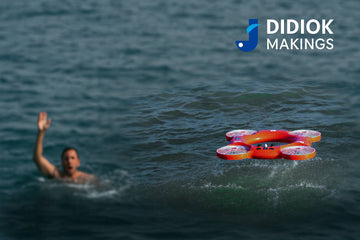When Seconds Matter, Safety Matters More
Water rescues are some of the most dangerous operations first responders face. The clock is ticking, conditions are unpredictable, and in many cases, rescuers put their own lives at serious risk just to reach the person in trouble.
Let’s be honest—no matter how skilled the team is, sending someone into rough or unknown water is never a decision taken lightly. Yet it's still common practice in many places.
But that’s changing.
The Hidden Dangers of Traditional Water Rescue
When a person falls into a river, lake, or coastal waters, every minute counts. But while responders rush to save the victim, they often expose themselves to life-threatening risks:
-
Strong currents that can sweep rescuers off their feet
-
Poor visibility, making it hard to locate victims or obstacles
-
Cold shock, which can hit even trained professionals
-
Unstable ground or hidden debris, especially during floods
-
Secondary incidents, like the rescuer needing to be rescued
These aren't just hypothetical problems—they happen. In many countries, rescue workers have died while trying to save others. The mission is noble, but the price can be devastating.
A Smarter Approach: Remote First, Humans Second
Thankfully, modern water rescue workflows are evolving. The new standard many agencies are adopting is this:
Send a remote-controlled rescue device first. Follow with personnel if necessary.
This approach dramatically reduces exposure for human responders, especially during the most dangerous first moments.
Here's how it typically works:
-
A remote-controlled drone or device is deployed within seconds.
-
It reaches the victim quickly—even in rough waters or strong currents.
-
The device provides flotation support or starts guiding the victim to safety.
-
Meanwhile, the rescue team plans a safer, more informed approach.
In many cases, victims can be stabilized or even brought back to shore without putting a single responder in the water.
The Role of the JX-6A Water Rescue Drone
One standout example of this technology shift is the JX-6A Water Rescue Drone.
Weighing under 5kg, it's compact enough to launch by hand, yet powerful enough to reach a person hundreds of meters away in less than a minute. Here's why teams are starting to trust it:
-
✅ 190N of buoyancy – enough to support an adult in the water
-
✅ IP68 waterproof rating – fully sealed and reliable in harsh conditions
-
✅ 6-grade wind resistance – performs even in choppy coastal weather
-
✅ Failsafe auto-return – if the signal cuts out, it turns back on its own
These aren’t flashy features—they’re practical tools that directly reduce the need for people to risk their lives.
It's Not About Replacing People—It's About Protecting Them
No machine can replace the skill, bravery, or compassion of a trained rescuer. But remote devices like the JX-6A can give them a better chance to go home safe.
They’re fast. They’re effective. And they remove the most dangerous element—the unknown—from those first critical moments of a rescue.
More and more departments are shifting toward a “remote first” strategy, not because it's trendy, but because it saves lives—on both ends of the rope.
Final Thoughts
If your department or organization is still relying solely on human-first rescue methods, it may be time to rethink your strategy. Remote-controlled rescue drones aren’t the future—they're the new normal.
And for good reason.
Want to see how the JX-6A can support your rescue team?
[Contact us] today to schedule a live demo or request technical specifications.





